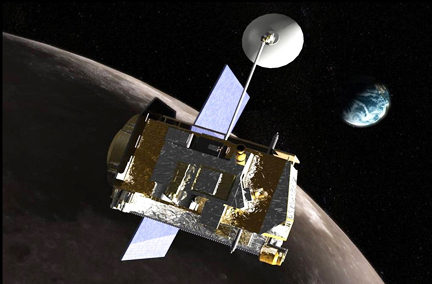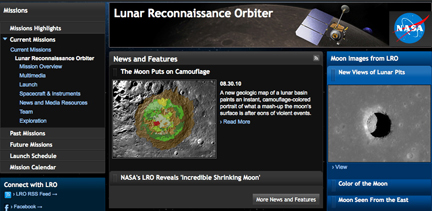NASA... LRO Heads Into Research From Exploration Mode
[SatNews] NASA's Lunar Reconnaissance Orbiter, or LRO, will complete the exploration phase of its mission on Sept. 16, after a number of successes that boosted the understanding of Earth's nearest neighbor.
LRO completed a one-year exploration mission in a polar orbit approximately 31 miles above the moon's surface. It produced a comprehensive map of the lunar surface in unprecedented detail; searched for resources and safe landing sites for potential future missions to the moon; and measured lunar temperatures and radiation levels. The mission is turning its attention from exploration objectives to scientific research, as program management moves from NASA's
Exploration Systems Mission Directorate to the
Science Mission Directorate at the agency's Headquarters in Washington. The LRO team will continue to send data gathered during the last year
to the
Planetary Data System, which archives and distributes scientific information from NASA planetary missions, astronomical observations and laboratory measurements.
 Artistic rendition of NASA's LRO
Artistic rendition of NASA's LRO
The spacecraft launched from NASA's Kennedy Space Center in Florida, carrying a suite of seven instruments, on June 18, 2009. LRO formally began its detailed survey of the moon in September 2009. Results from the mission include: new observations of the Apollo landing sites; indications that permanently shadowed and nearby regions may harbor water and hydrogen; observations that large areas in the permanently shadowed regions are colder than Pluto; detailed information about lunar terrain; and the first evidence of a globally distributed population of thrust faults that indicates the moon has recently contracted and may still be shrinking. LRO also took high resolution pictures of the
Lunokhod 1 rover that had been lost for almost 40 years. The rover, which carries a retroreflector, was located to within approximately 150 feet. The accurate position data enabled researchers on Earth to bounce laser signals off the retroreflector for the first time ever. The retroreflector is providing important new information about the position and motion of the moon. LRO also supported the
Lunar Crater Observation and Sensing Satellite impact, a companion mission sent to determine if the moon's poles
harbor water ice, by helping to select a promising impact site. LRO observed both the expanding plume that arose after the impact and the evolving temperature at the site.
Topical Tags :
Regional Tags :



